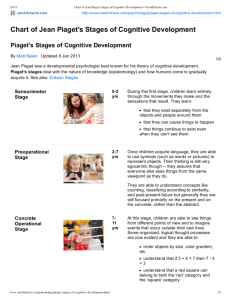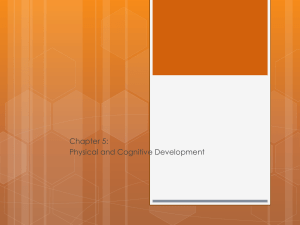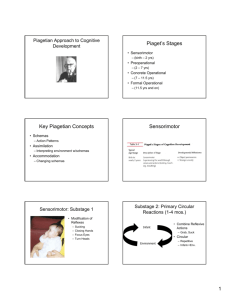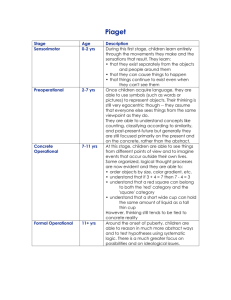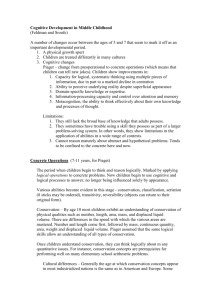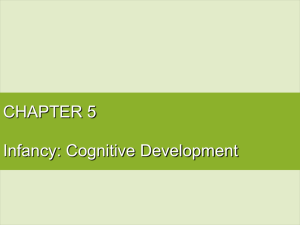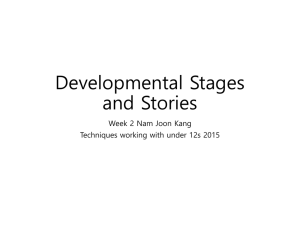Cognitive Development Physical and Cognitive Development
advertisement
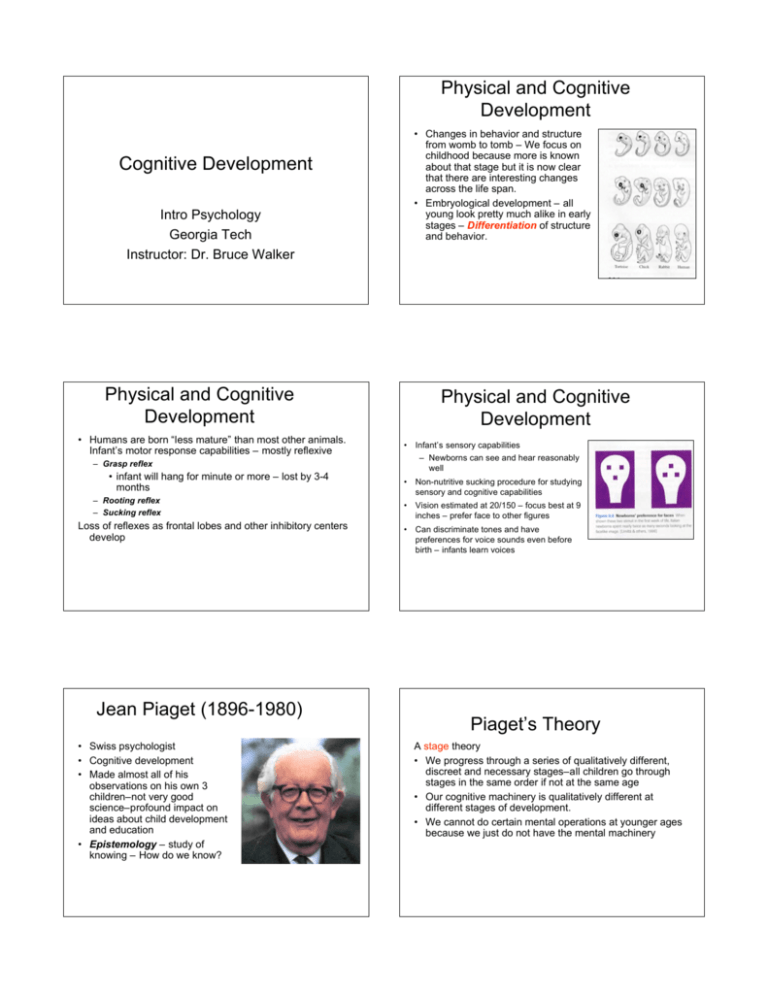
Physical and Cognitive Development • Changes in behavior and structure from womb to tomb – We focus on childhood because more is known about that stage but it is now clear that there are interesting changes across the life span. • Embryological development – all young look pretty much alike in early stages – Differentiation of structure and behavior. Cognitive Development Intro Psychology Georgia Tech Instructor: Dr. Bruce Walker Physical and Cognitive Development • Humans are born “less mature” than most other animals. Infant’s motor response capabilities – mostly reflexive Physical and Cognitive Development • – Newborns can see and hear reasonably well – Grasp reflex • infant will hang for minute or more – lost by 3-4 months – Rooting reflex – Sucking reflex Loss of reflexes as frontal lobes and other inhibitory centers develop Jean Piaget (1896-1980) • Swiss psychologist • Cognitive development • Made almost all of his observations on his own 3 children–not very good science–profound impact on ideas about child development and education • Epistemology – study of knowing – How do we know? Infant’s sensory capabilities • Non-nutritive sucking procedure for studying sensory and cognitive capabilities • Vision estimated at 20/150 – focus best at 9 inches – prefer face to other figures • Can discriminate tones and have preferences for voice sounds even before birth – infants learn voices Piaget’s Theory A stage theory • We progress through a series of qualitatively different, discreet and necessary stages–all children go through stages in the same order if not at the same age • Our cognitive machinery is qualitatively different at different stages of development. • We cannot do certain mental operations at younger ages because we just do not have the mental machinery Stages according to Piaget’s theory Piaget’s Theory • Schema – Schemata – a cognitive structure or pattern by which we organize the world • Assimilation – we incorporate our experiences of the world into existing schemata • Accommodation – we also change schemata when necessary Cognitive development is a continual process of assimilating as long as possible and then accommodating by making new schemata • • • • Sensorimotor Period – birth to 2 years Preoperational Period – 2-7 Concrete Operations – 7-11 Formal Operations – 11 on Substage 1: Birth-1 month • Rigid, stereotyped reflexive actions • Reflexive imitations • No object concept Substage 3: 4-8 months Substage 2: 1-4 months • – actions that elicit responses from others (e.g,. cooing may elicit smiling from another, and more cooing) • Primary circular reactions – actions and responses both involve infants own body (e.g., sucking thumb, laughing) Secondary circular reactions • Creep, crawl, climb to explore • True imitation of actions baby already performs • Exploration of body • First glimmerings of object concept • Perceptual integration • Recognition memory helps establish: • Eye-hand coordination • Pseudoimitation • No object concept – Object permanence – Social attachment Developmental Studies of Object Perception Developmental Studies of Object Perception Developmental Studies of Object Perception Developmental Studies of Object Perception • Basic principles used by 4 month old infants – Cohesion – moving objects maintain their shape and boundaries – Contact – objects move together only if they touch. – Continuity – objects trace a continuous path through space If motion is smooth, then infants appear unsurprised by change in object shape Substage 4: 8-12 months • Communication by gesture and speech • Stereotyped actions applied to new objects • Observational learning through immediate imitation of simple actions • Intentionality shown by: – Removal of obstacles to obtain goals – Use of instruments as tools Substage 5: 12-18 months • Tertiary circular reactions – actions that lead to pleasing results lead infant to perform similar actions (squeeze a duck get a response, now step on it) • Perhaps some deferred imitation of very simple, single actions • Solution of problems through overt trial and error • Searches for toy in last hiding place, but only if sees researcher move it • Uses tools in novel ways Preoperational Stage • 2-7 years • child can now represent objects not present and can think about actions that are not being performed – called Representational Thinking • Deferred imitation – imitate behavior long after it was seen (can be observed at the end of sensorimotor period after object permanence develops) Appearance-reality distinctions • 2-3-year-olds do not easily discriminate what things look like from what things are • Problem is dual nature of object and conflicting information • Occurs in many cultures • Resists simple training Concrete Operations Stage • Classification – concrete operational child can classify objects into hierarchies and, unlike the preoperational child, can think about addition of classes – sort 8 poodles, 3 cats, and 2 collies – If asked “are there more dogs or poodles?” the preoperational child will say poodles, concrete operational child will say dogs Preoperational Stage • Failure of conservation – liquid quantity – number (checkers) – mass (clay) • These occur because the child cannot think of both dimensions at the same time and trade one off against the other Concrete Operations Stage • 7-11 years • child is able to manipulate 2 variables at the same time so has developed schemas necessary for conservation – the child can mentally coordinate the two states of the liquid in the glass for example. Concrete Operations Stage • Concrete child cannot think hypothetically or carry out systematic hypothesis testing. On a fulcrum problem, for example, concrete operations child can add or subtract weights OR if weights are unequal in distance, can move one closer or farther but can not do both to achieve balance • Formal operations child can do this – marked by systematic hypothesis testing of several variables Understanding false beliefs: A key test of understanding another’s mental state • Wimmer & Perner (1983) devised a task to assess children’s ability to take into account what someone else thinks.. • In their task, children were shown a story where a character comes to believe something incorrect about the world. Children were required to predict what action the character would take. • Generally, children cannot pass the false belief task until they are 4years-old. They tend to predict that the character would act on the basis of what the child themselves knew to be true – what Piaget would have called ‘egocentrism’. Upcoming • • • • Intelligence Social development Exam 2 Social cognition Emerging Theory of Mind • 3-5-year-olds distinguish real from imagined objects • False beliefs • Requires differentiation of self from others; mental vs. physical world


